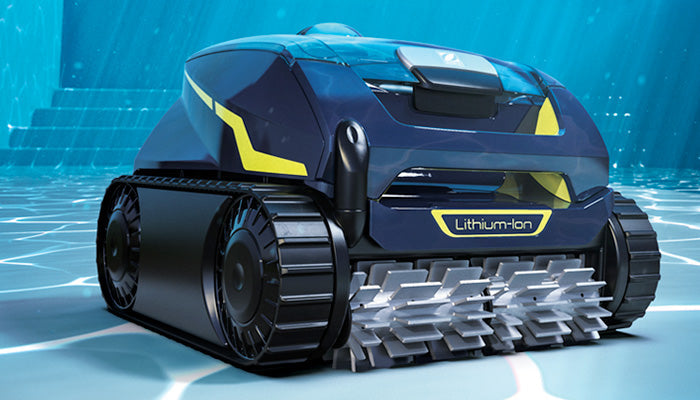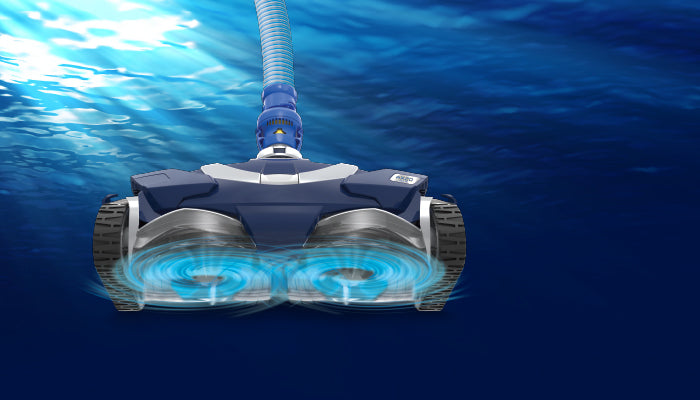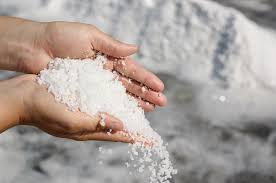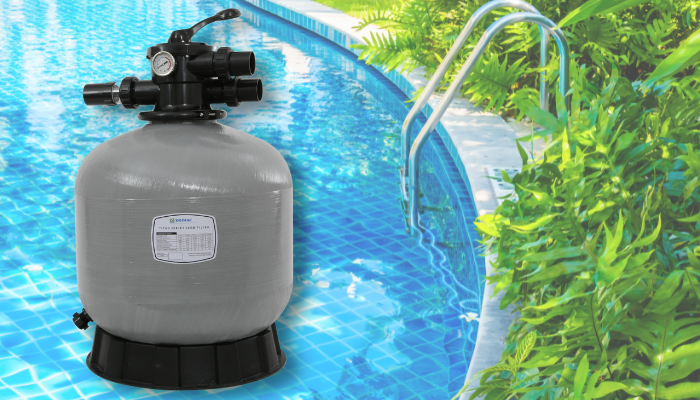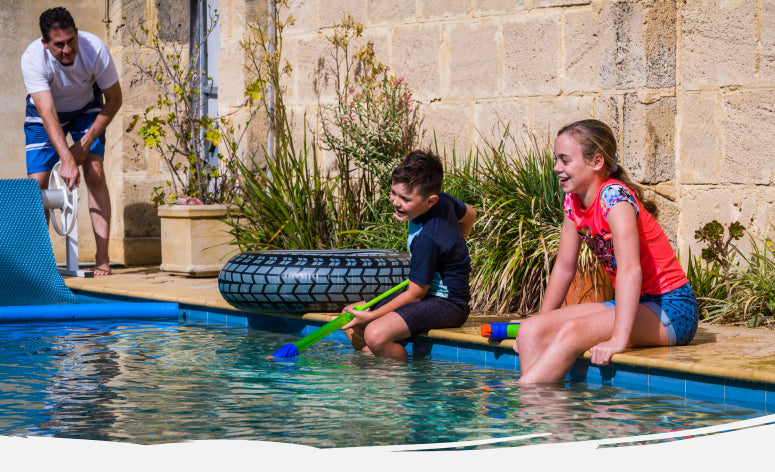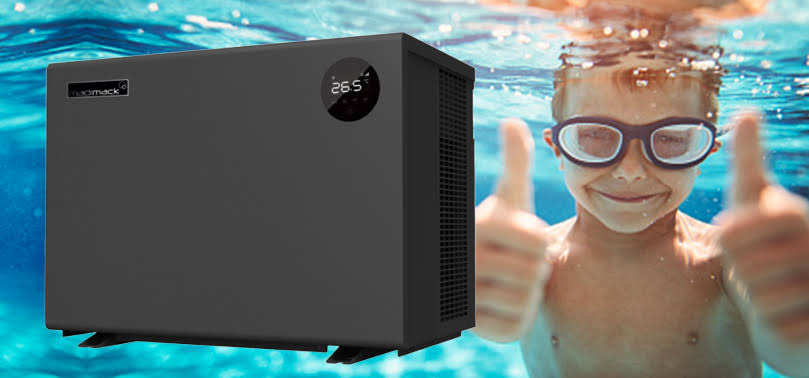The dreaded mustard algae currently doing the rounds again!
🟡 Mustard Algae in Your Pool
The sneaky, stubborn algae that's harder to kill than you think — and why treating it properly is absolutely critical
You notice something yellow on your pool floor. You brush it off. It comes back. You brush harder. It returns again. That stubborn yellowish dust isn't sand, dirt, or pollen — it's mustard algae, and it's one of the most frustrating pool problems any Perth pool owner can face. Unlike common green algae, mustard algae is chlorine-resistant, incredibly persistent, and can survive outside your pool water on swimsuits, toys, and equipment — ready to reinfect your pool at any moment.
What Is Mustard Algae?
Mustard algae (also called yellow algae) is a chlorine-resistant form of green algae that belongs to the xanthophyte family. Unlike its green cousin that floats freely and turns your entire pool murky, mustard algae clings stubbornly to pool surfaces — walls, floors, steps, ladders, and particularly shady areas where water circulation is poorest.
🔬 Scientific Classification
A subclass of green algae (Chlorophyta) that has developed compounds which act as a defence mechanism against chlorine and other sanitisers, allowing it to survive even in properly chlorinated pools.
🌡️ Preferred Conditions
Thrives in warm climates (hello Perth summers!), fresh water, and particularly loves shaded areas of your pool where chlorine is less effective and water circulation is weak.
How to Identify Mustard Algae
One of the trickiest things about mustard algae is that it doesn't look like typical pool algae. It's often misidentified as sand, dirt, pollen, or even a metal stain — leading to delayed treatment and further spread.
📸 Visual Identification Guide

Typical appearance: dusty yellow deposits on pool floor and shaded walls

Mustard algae loves shaded corners, steps, and areas with poor circulation
Key Identifying Characteristics:
-
1
Colour: Yellowish, yellow-green, yellow-brown, or sometimes greyish — resembles mustard or sand
-
2
Texture: Fine, dusty appearance; may feel slightly slimy when touched
-
3
Location: Clings to walls, floors, steps, behind ladders, in corners — especially shaded areas
-
4
Behaviour: Brushes off easily but returns within 24-48 hours
-
5
Water Clarity: Pool water often remains clear — this is what catches people off guard!
🧪 The Simple Brush Test
Not sure if it's mustard algae? Take your pool brush and scrub a suspicious yellow spot:
- If it disperses into a cloud → Mustard algae ✓
- If it moves around but doesn't cloud up → Probably sand
- If it stays firmly in place → Likely a metal stain
- If it comes off easily but returns within 1-2 days → Definitely mustard algae ✓
What Causes Mustard Algae?
Understanding what causes mustard algae helps you both treat current outbreaks and prevent future ones. Here in Perth, our warm climate makes us particularly susceptible to this stubborn invader.
Contaminated Equipment & Swimwear
The #1 way mustard algae enters your pool. Spores hitchhike on swimsuits, pool toys, floats, cleaning equipment, garden hoses — even pets! Items used in another contaminated pool or natural body of water can introduce algae spores.
Warm Water Temperatures
Mustard algae thrives in warm, sunny conditions — making Perth summers the perfect breeding ground. If you heat your pool, you're even more susceptible. High temperatures accelerate growth significantly.
Poor Water Circulation
Stagnant water = algae heaven. Dead zones where water doesn't flow properly — corners, behind ladders, under steps — become prime real estate for mustard algae to settle and multiply.
Imbalanced Water Chemistry
Low or inconsistent chlorine levels, improper pH, high phosphates, or elevated carbon dioxide and nitrates all create conditions where mustard algae can take hold — even a brief lapse is enough.
Storm & Weather Events
Heavy rain, flooding, and strong winds can introduce airborne spores or ground contamination into your pool. Storms also dilute your chemicals and introduce debris that feeds algae growth.
Neglected Pool Maintenance
Irregular cleaning, infrequent brushing, skipping vacuuming, and not running your pump long enough all allow organic debris to accumulate — providing food and shelter for algae to establish.
⚠️ Critical Warning: Why Mustard Algae Is Different
Mustard algae can survive OUTSIDE your pool water. This is what makes it so incredibly difficult to eliminate permanently. The spores attach to:
Swimsuits & Towels
Pool Toys & Floats
Robotic Cleaners
Brushes & Vacuums
Ladders & Rails
Pool Lights & Fittings
If you treat your pool water but don't sanitise EVERYTHING that's been in contact with it, the algae WILL return. This is why most DIY treatments fail.
Is Mustard Algae Dangerous?
Mustard algae itself isn't directly harmful to humans in small amounts. However, there are legitimate reasons why you shouldn't swim in a pool with an active algae infestation:
- Bacterial Harbour: Algae overgrowth can harbour harmful bacteria including E. coli, creating unsanitary swimming conditions
- Chlorine Depletion: Algae consumes chlorine, meaning there's less available to sanitise against other pathogens
- Surface Damage: Left untreated, mustard algae can cause permanent staining on pool surfaces
- Equipment Damage: Algae clogs filters and reduces their effectiveness, potentially damaging your filtration system
- Cloudy Water: Even if water looks clear initially, dead algae can cause significant cloudiness
Complete Treatment Protocol
🎯 Before You Begin: Set Your Expectations
Be warned: mustard algae treatment is NOT a quick fix. It requires patience, thoroughness, and discipline. Miss a step or cut corners, and you'll be starting over. Some stubborn cases require multiple treatment cycles. If your first treatment doesn't completely eliminate the algae, don't be discouraged — persistence is key.
Step-by-Step Treatment Guide
1 Remove & Sanitise ALL Pool Equipment
This step is NON-NEGOTIABLE. Remove everything from your pool and surrounding area:
- Pool toys, floats, noodles, inflatable items
- Robotic pool cleaner (including its caddy and cable)
- Manual vacuum heads, hoses, and poles
- Pool brushes and leaf scoops
- Removable ladders or handrails
How to sanitise: Soak items in a dilute chlorine solution (approximately 1 part liquid chlorine to 10 parts water) for at least one hour, or scrub with a multipurpose cleaner containing bleach. Allow to dry completely in the sun.
🩱 Swimsuits & Towels: Wash ALL swimsuits, towels, and pool attire in hot water with a colour-safe laundry detergent. Use bleach if the fabric allows. Dry thoroughly in a hot dryer.
2 Clean & Backwash Your Filter
Mustard algae lives in your filter too. Before treatment, thoroughly clean your filter media:
- Sand filters: Perform a complete backwash and rinse cycle
- Cartridge filters: Remove and hose off cartridges, or soak in filter cleaner solution
- DE filters: Backwash and recharge with fresh DE powder
3 Balance Your Water Chemistry
Test and adjust your water to optimal treatment levels:
| Parameter | Target Level |
|---|---|
| pH | 7.0 – 7.2 (lower than normal for better chlorine effectiveness) |
| Total Alkalinity | 80 – 120 ppm |
| Free Chlorine | 2.0 – 3.0 ppm (before shocking) |
Note: Lowering pH to 7.0-7.2 softens algae's protective waxy coating, allowing chemicals to penetrate more effectively.
4 Brush EVERYTHING Thoroughly
This step is your workout for the day! Use a stiff pool brush (wire-bristle for concrete/pebblecrete, nylon for fibreglass/vinyl) and scrub:
- All walls, floor, and steps
- Behind ladders and around fittings
- Inside skimmer boxes
- Around underwater lights (remove and brush inside the niche if possible)
- Every corner, crack, and crevice
Purpose: Brushing destroys the algae's cellular structure and protective layer, pushing it into the water where chemicals can kill it.
5 Superchlorinate (Shock) Your Pool
Mustard algae requires a HIGHER shock dose than green algae. Because it's chlorine-resistant, you need to hit it hard:
- Use liquid chlorine (sodium hypochlorite) for fastest action
- Dose at approximately 20 litres per 50,000 litres of pool water
- Add 19L around the pool perimeter and 1L directly into the skimmer to sterilise the filter
- For stubborn cases, you may need to shock 2-3 times, waiting 12 hours between applications
⏰ Timing: Shock at dusk or night for best results — UV sunlight degrades chlorine rapidly.
6 Apply Algaecide
After shocking (not at the same time), add a quality algaecide specifically effective against mustard algae. We recommend Lo-Chlor products for their proven effectiveness:
7 Run Filtration 24/7 & Monitor
Keep your pump running continuously for at least 24-48 hours during treatment. This ensures chemicals circulate thoroughly and dead algae is captured by your filter.
- Backwash/clean filter every 12 hours during treatment
- Vacuum any debris to waste (if your system allows)
- Run any water features (fountains, waterfalls) for at least an hour while chlorine is elevated
- Test water daily until algae is completely gone
Recommended Lo-Chlor Algaecides for Mustard Algae
We specifically recommend Lo-Chlor algaecides for treating mustard algae. These Australian-made products have been the industry standard since the late 1970s and remain the most effective and reliable algaecides available.
📋 Important Usage Notes for Lo-Chlor Algaecides
- Do NOT superchlorinate for 48 hours before or after using copper-based Lo-Chlor algaecides
- Do NOT use in pools with ionisers or Nature2 systems — use Algae Knock-Out instead
- Always test phosphate levels after adding algaecide — remove phosphates with Lo-Chlor Starver for best results
- Reduce pH to 7.0-7.2 before treatment — this softens algae's waxy coating
- Copper-based algaecides may combine with chlorine gases in salt chlorinator cells, causing temporary surface bubbles (dissipates in 5-7 days)
💯 The Honest Truth About Mustard Algae Treatment
We need to be upfront with you: mustard algae cannot always be eliminated 100% on the first attempt. This isn't a failure of the products or your effort — it's the nature of this stubborn organism.
Why Treatment Sometimes Requires Multiple Rounds:
- Spores hide in microscopic cracks and crevices
- Some equipment may not have been sanitised thoroughly enough
- The protective compounds make some cells more resistant than others
- Re-introduction from contaminated items you didn't realise were affected
- Filter wasn't cleaned completely, harbouring surviving spores
If your first treatment doesn't completely eliminate the algae, don't give up. Be even more thorough with equipment cleaning and repeat the process. Most stubborn cases resolve with 2-3 treatment cycles.
🤖 Special Note: Your Robotic Pool Cleaner
If you have a robotic pool cleaner (Maytronics Dolphin, Zodiac, Kreepy Krauly, etc.), this deserves special attention. Your robot has been crawling through contaminated water, and mustard algae spores will be lurking:
- Remove the robot from the pool before starting treatment
- Clean all filter cartridges/bags thoroughly — soak in dilute chlorine solution
- Wipe down the entire body including wheels, tracks, and brushes
- Flush the cable — drag it through your elevated chlorine pool water
- Clean the caddy/storage unit — often overlooked!
- Do NOT put the robot back in until treatment is complete and verified
- Consider running it with fresh filter media once the pool is clear
Prevention: Keeping Mustard Algae Away for Good
Once you've won the battle, the last thing you want is a repeat performance. Here's how to prevent mustard algae from returning:
💧 Maintain Proper Chemistry
Keep free chlorine at 3-4 ppm consistently. Test 2-3 times per week, especially in hot weather. Never let chlorine drop below 1 ppm.
🔄 Ensure Good Circulation
Run your pump 8-12 hours daily minimum. Check for dead zones and adjust return jets to eliminate stagnant areas.
🧹 Regular Brushing
Brush walls and floor weekly, paying special attention to shaded areas, corners, steps, and behind ladders.
🧪 Use Preventative Algaecide
Add Lo-Chlor Pool Algaecide quarterly for ongoing protection — one dose lasts up to 90 days.
🩱 Clean Before Swimming
Rinse swimsuits after use elsewhere. Wash all pool toys and equipment that may have been in other pools or natural water.
📊 Remove Phosphates
Test and treat phosphates regularly — they're the food source for algae. Use Lo-Chlor Starver to keep levels below 100 ppb.
📞 When to Call a Professional
While mustard algae can be treated DIY, there are situations where professional help is the smarter choice:
- You've tried 2-3 treatment cycles with no success
- The algae keeps returning within days of treatment
- You're unsure about proper chemical dosing for your pool size
- Your pool has complex features (waterfalls, spas, multiple water features)
- You don't have time for the thorough, multi-day treatment process
- You suspect the algae may have damaged your pool surface
Poolwise Padbury offers professional pool servicing throughout Perth's northern suburbs. We have the experience, equipment, and products to tackle even the most stubborn mustard algae infestations. Contact us for a consultation.
✅ Quick Reference Treatment Checklist
Remove all toys, floats & equipment from pool
Remove robotic cleaner (clean separately)
Sanitise all removed items in chlorine solution
Wash all swimsuits & towels in hot water
Clean/backwash filter thoroughly
Test & balance water chemistry
Lower pH to 7.0-7.2
Brush entire pool thoroughly (walls, floor, steps)
Brush behind ladders, around lights & fittings
Superchlorinate/shock pool at dusk
Run pump 24 hours continuously
Apply Lo-Chlor algaecide after shocking
Backwash filter every 12 hours during treatment
Test daily until clear, rebalance as needed
Need Help With Mustard Algae?
We stock the full range of Lo-Chlor algaecides and can provide expert advice on treating your specific mustard algae problem. Visit our store or get in touch.
Disclaimer: This guide is intended for general information purposes. Always read and follow product label directions carefully. Chemical dosages should be calculated based on your specific pool volume. If you're uncertain about any aspect of pool chemical treatment, consult a qualified pool professional. Poolwise Padbury accepts no liability for outcomes resulting from the application of information in this article.
